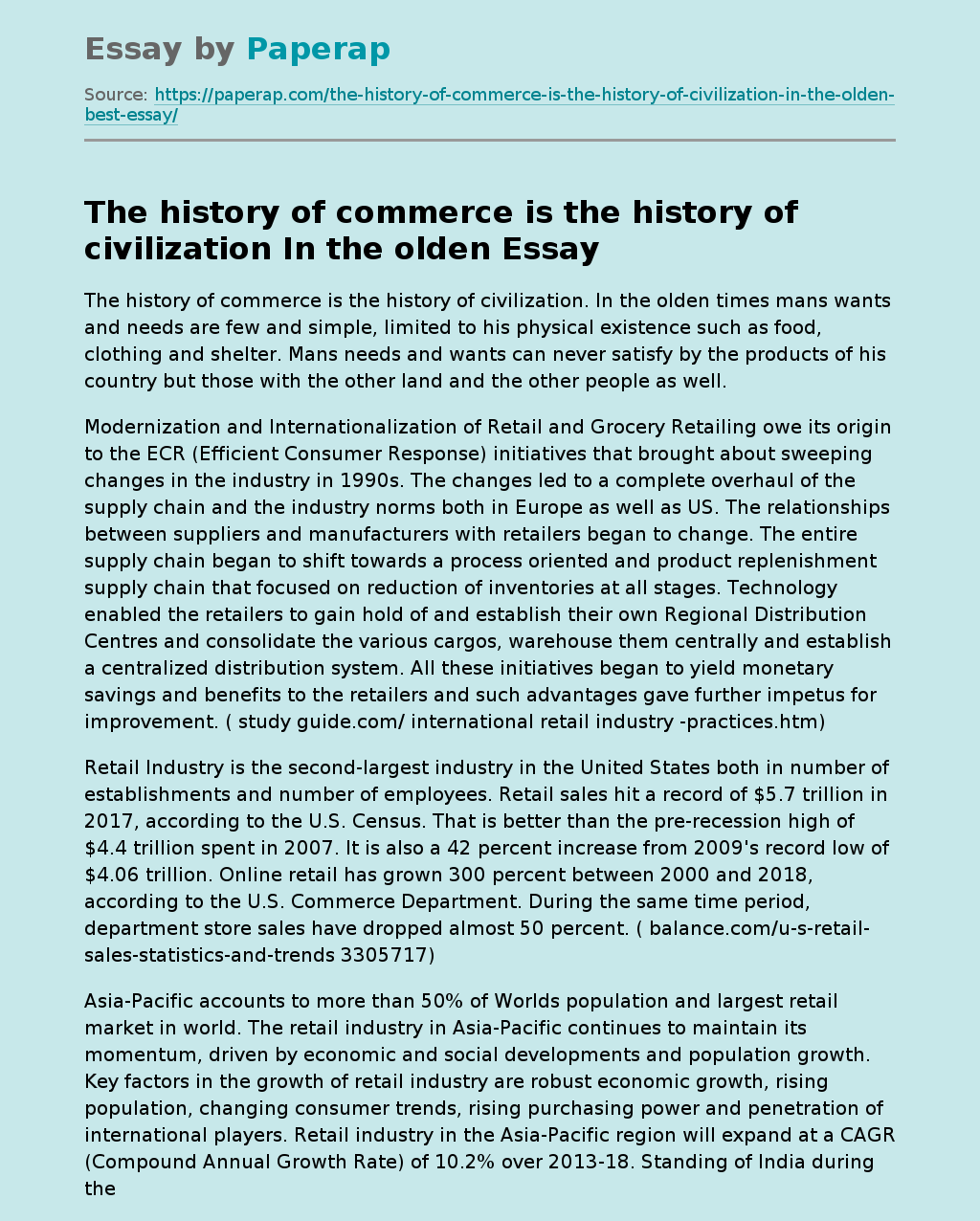The History of Commerce Is the History of Civilization
In the olden times mans wants and needs are few and simple, limited to his physical existence such as food, clothing and shelter. Mans needs and wants can never satisfy by the products of his country but those with the other land and the other people as well.
Modernization and Internationalization of Retail and Grocery Retailing owe its origin to the ECR (Efficient Consumer Response) initiatives that brought about sweeping changes in the industry in 1990s. The changes led to a complete overhaul of the supply chain and the industry norms both in Europe as well as US.
The relationships between suppliers and manufacturers with retailers began to change.
The entire supply chain began to shift towards a process oriented and product replenishment supply chain that focused on reduction of inventories at all stages. Technology enabled the retailers to gain hold of and establish their own Regional Distribution Centres and consolidate the various cargos, warehouse them centrally and establish a centralized distribution system.
All these initiatives began to yield monetary savings and benefits to the retailers and such advantages gave further impetus for improvement.
Retail Industry is the second-largest industry in the United States both in number of establishments and number of employees. Retail sales hit a record of $5.7 trillion in 2017, according to the U.
S. Census. That is better than the pre-recession high of $4.4 trillion spent in 2007. It is also a 42 percent increase from 2009’s record low of $4.06 trillion. Online retail has grown 300 percent between 2000 and 2018, according to the U.S. Commerce Department. During the same time period, department store sales have dropped almost 50 percent.
Asia-Pacific accounts to more than 50% of Worlds population and largest retail market in world. The retail industry in Asia-Pacific continues to maintain its momentum, driven by economic and social developments and population growth. Key factors in the growth of retail industry are robust economic growth, rising population, changing consumer trends, rising purchasing power and penetration of international players. Retail industry in the Asia-Pacific region will expand at a CAGR (Compound Annual Growth Rate) of 10.2% over 2013-18. Standing of India during the period is most optimistic, with an expected CAGR of above 16% followed by Indonesia with a CAGR of 14%, China and Vietnam. Other Asia-Pacific nations are expected to register a CAGR of 1%, 12%, least by Japan with a CAGR of less than 2%.
Philippines is always a disaster prone country and thus consumption of FMCG (Fast Moving Consumer Goods), goods can increase or decrease suddenly. Philippines retail market is driven by large and young consumers market base and an expanding middle class with high disposable income. The retail industry in Philippines continues to maintain its momentum, driven by economic and social developments and population growth. Key factors in the growth of retail industry are rising population, growing youth segment, changing consumer trends and rising purchasing power. Philippine retail sales grew by 10.6% year-on-year in the 1st half of 2016, with retail sales totaling P926 billion for the period, according to data from the Philippine Statistics Authority (PSA). ( Philippines)
Statistics shows that almost 50% of the countrys population of almost 80 million belongs to the poverty line. Because of this, business analysts described the prevailing situation as synonymous to a sachet phenomenon, a sari-sari store. The Role of Sari-sari and its Retail technique in the Philippine Culture (2016) Most of the consumers in Philippines prefers cheap and best goods. The traditional Sari convenience store (variety stores) dominates the market because the demand is mostly cheap. ( Philippines)
Sari-sari stores are small retail outlets that can be found in almost all neighbourhoods, sometimes even in every street corner in the Philippines. Most of these are privately owned shops and operated inside the store owners house. Commodities are displayed in a large screen-covered or metal barred window in front of the shop. Candies, canned goods and cigarettes are often displayed while cooking oil, salt and sugar are often stored in sacks or cans. A small window is also present where customers requested commodity is given.
Setting up a sari-sari store in the Philippines is not as complicated as many other businesses. If you have a vacant space in the backyard, skills in carpentry, basic arithmetic and small capital you can establish you micro retail facility. It can be a good source of income; it can average a net profit margin of 20%. Weve heard stories of families who were able to send their children to college with the earnings from sari-sari store. Manarang (2017)
In the Municipality of San Juan, La Union there were 851 registered businesses in 2017 where 362 are sari-sari stores (Treasury Office, LGU, San Juan, La Union). However, as per initial observations, not long after the sari-sari stores have opened for business, the number of customers slowly decreases, products began to dwindle and sooner than expected the once promising business establishments close for operations. It is a sad tale of failed attempts at entrepreneurship that is common among aspiring local business folks. The reasons for closure are insufficiency of funds, wrong practices in cash management, limited knowledge of the owner himself in bookkeeping and management, excessive receivables, inavailability of consumer goods, no advertising and non-profitability.
In view of the foregoing situationer among sari-sari stores in San Juan, La Union an in-depth study on the management systems is needed to serve as a guide in the formulation of a management program that will help in accelerating its management systems and contribute to its sustainability as well.
The History of Commerce Is the History of Civilization. (2019, Dec 02). Retrieved from https://paperap.com/the-history-of-commerce-is-the-history-of-civilization-in-the-olden-best-essay/

